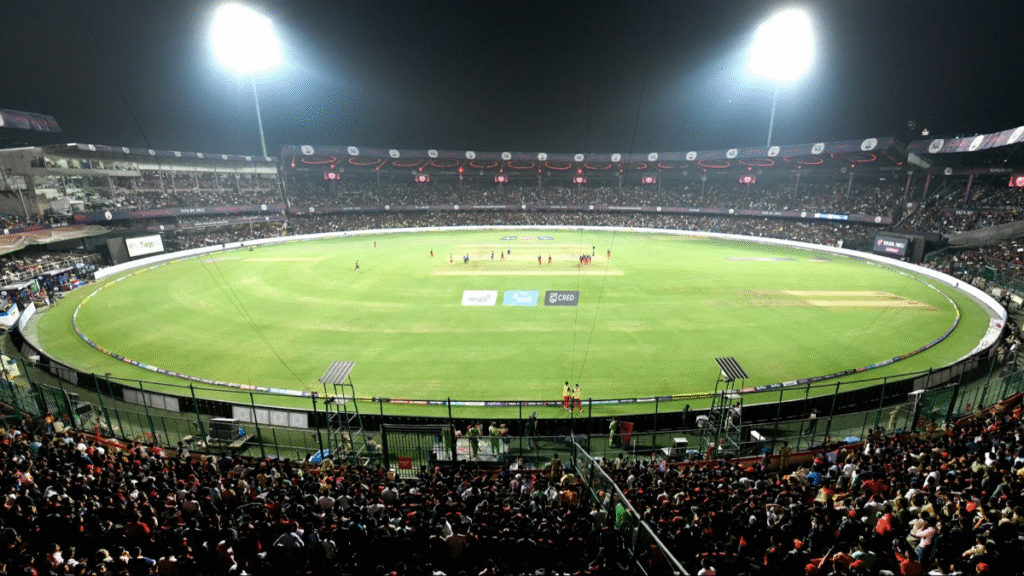Chinnaswamy Stadium Banned for Large‑Scale Events — A New Chapter
Here’s a polished blog‑style roundup (≈ 700 words) on the latest ban placed on Bengaluru’s M. Chinnaswamy Stadium following the tragic stampede:

🏟️ Title: Chinnaswamy Stadium Banned for Large‑Scale Events — A New Chapter
Introduction
On 4 June 2025, joyous IPL celebrations at Bengaluru’s famed Chinnaswamy Stadium turned into a nightmare. A massive crowd crush during Royal Challengers Bengaluru’s victory event caused widespread panic. The result: 11 lives lost and over 50 injured. The incident prompted a judicial probe headed by Justice John Michael D’Cunha. The outcome is seismic: the stadium has been officially declared unsafe for high‑attendance events.
📌 What the Commission Found
- The stadium’s design and infrastructure were labelled fundamentally flawed for large gatherings. The layout lacks sufficient ingress‑egress capacity and emergency exits.
- Such events carry unacceptable risks—to public safety, traffic flow, and ability to respond to emergencies.
- Authorities concluded that continuing to host big events without major upgrades would invite disaster.
⚠️ Key Consequences
- Immediate ban on large‑scale public events.
- The 2025 Women’s ODI World Cup, originally slated to begin and conclude at Chinnaswamy, is thrown into uncertainty.
- IPL 2026 home matches for RCB are now in jeopardy, and speculation intensifies that the franchise may be forced to relocate for the tournament.
👥 Accountability & Fallout
- The report held several stakeholders responsible: the Karnataka State Cricket Association (KSCA), RCB management, DNA Entertainment, and certain senior police officers.
- Legal and disciplinary actions are pending: former KSCA officials and event organizers could face notices, and suspended officers may challenge their removal.
- Discussions in the state cabinet have turned intense, and high-level resignations have already followed.
🛑 What’s Next?
- KSCA has announced the Maharaja Trophy T20 League (scheduled for August) will proceed but with no spectators.
- Potential alternate venues are in the spotlight—Pune’s MCA Stadium, Dharamsala, and Nagpur’s Vidarbha Stadium are being considered for RCB’s future home games.
📝 Recommendations from the Inquiry
The commission urged immediate reforms:
- Shift major events to venues meeting international safety standards—adequate gates, crowd flow planning, emergency evacuation routes.
- Implement timely communication protocols, including public information about entry passes and crowd capacity limits.
- Require detailed emergency-response plans, real‑time surveillance, and mass‑gathering risk modeling.
- Establish strict event approval processes, with state and city authorities granting clearance only after verifying safety compliance.
💬 Local & Public Reaction
- Families of the victims continue to receive support: state compensation, RCB’s personal aid pledges, and commitments to cover medical costs.
- Public sentiment is sharply divided—many mourn and demand swift accountability.
- Social media has seen an outpouring of support for some police officers deemed scapegoated; others demand systemic reform, not just symbolic action.
🌍 Broader Implications
This ban signals a turning point—not just for Bengaluru cricket, but for how India handles crowd safety in large venues. Urban densification and rising event-scale require urgent infrastructure upgrades and tougher regulation. Until those changes are enforced, iconic sporting venues like Chinnaswamy must remain on probation.
⏯️ Timeline Recap
| Date | Event |
|---|---|
| 4 June 2025 | Stampede during RCB victory leads to 11 deaths and 50+ injuries |
| Post‑incident | Justice D’Cunha Commission formed to investigate |
| Late July 2025 | Commission report submitted and accepted; stadium declared unsafe |
| Tshadesh | Ban announced on mass‑attendance events; key matches in doubt |
| Immediate | Satellite venues evaluated; behind‑closed‑doors scheduling adopted |
🏁 Final Thoughts
Chinnaswamy Stadium has long been a jewel in India’s sporting landscape. But this crisis has exposed glaring gaps in infrastructure and planning. While the ban may feel draconian to some, it reflects a broader mandate: safety must come before spectacle. For immediate relief, matches may relocate or proceed without spectators. For the long term, substantial retrofitting—and perhaps fresh venues—are essential.
The next weeks will determine whether Bengaluru takes a firm stance on crowd safety or settles for token responses. For RCB fans and cricket followers, change is no longer optional—it’s imperative.
